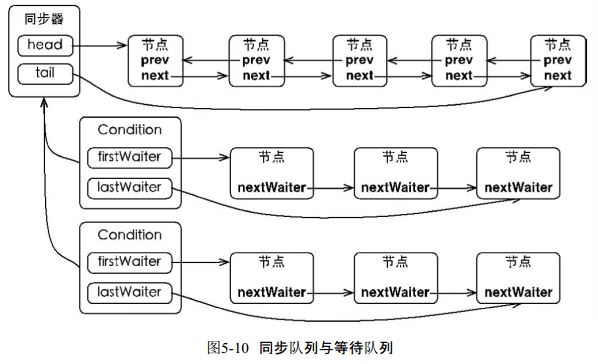要理解Lock首先要理解AQS,而要理解并发类最好的方法是先理解其并发控制量不同值得含义以及该类运作流程,然后配合一步步看源码。
该类有一个重要的控制量是WaitStates。
/** waitStatus value to indicate thread has cancelled */ static final int CANCELLED = 1; //该节点被取消了 /** waitStatus value to indicate successor's thread needs unparking */ static final int SIGNAL = -1; //该节点后续节点需要被唤醒 /** waitStatus value to indicate thread is waiting on condition */ static final int CONDITION = -2; //该节点进入了等待队列,即Condition的队列里 /** * waitStatus value to indicate the next acquireShared should * unconditionally propagate */ static final int PROPAGATE = -3; //共享节点,该节点进锁后会释放锁,。
AQS流程图:


Condition与Lock配合:

源码分析:核心方法 aquaire和release及他们方法体里使用到的方法。
public final void acquire(int arg) { if (!tryAcquire(arg) && //如果tryacquire失败 且 队列里获取节点成功 且被中断过 acquireQueued(addWaiter(Node.EXCLUSIVE), arg)) selfInterrupt();//当前线程中断 interrupt() //说下中断的事,1、如果在acquireQueued过程线程被interrupt,如果线程没进入等待状态,并不会中断线程。只是改变interrupt变量 // 且被传回到这里(因为是用interrupted,所以返回true之后又把线程的interrupt变量设为false)。然后selfinterrupt,将interrupt变量设为true。 // 2、如果线程被park了然后被interrupt,则被唤醒,循环一次发现还是阻塞又进入park等待状态。直到被unpark,interrupt参数为true传回到这里。 //然后interrupt参数又变回false(受interrupted影响),selfinterrupt则又把它设为true。 }
final boolean acquireQueued(final Node node, int arg) {//从队列里尝试获取锁 boolean failed = true; try { boolean interrupted = false; for (;;) { final Node p = node.predecessor();//前节点 if (p == head && tryAcquire(arg)) {//前节点为头节点,且尝试获取锁获取到了。则清理前节点, setHead(node); //head指向现节点 p.next = null; // help GC failed = false; return interrupted; } //shouldParkAfterFailedAcquire如果前节点为-1则返回true,如果0(初始),-3(共享)则设为-1,如果1则 // 找到前面<-0的节点连他后面 //parkAndCheckInterrupt 阻塞当前线程,并返回interrupted状态(阻塞则设置失败),并清除中断状态 if (shouldParkAfterFailedAcquire(p, node) &&//前节点状态为-1 return true parkAndCheckInterrupt()) //中断状态为true return true interrupted = true; } } finally { if (failed) cancelAcquire(node);//节点取消获取,队列中删除节点, } }
private static boolean shouldParkAfterFailedAcquire(Node pred, Node node) {//获取失败后判断是否暂停该线程 int ws = pred.waitStatus; if (ws == Node.SIGNAL)//前节点处于当前节点后面的节点需要被唤醒状态 /* * This node has already set status asking a release * to signal it, so it can safely park. */ return true; if (ws > 0) {//前节点处于取消状态 /* * Predecessor was cancelled. Skip over predecessors and * indicate retry. */ do {//当前节点找到前面状态<=0的节点连他后面。 node.prev = pred = pred.prev; } while (pred.waitStatus > 0); pred.next = node; } else {//如果前节点不处于取消状态,则设为signal -1.(0或-3设为-1) /* * waitStatus must be 0 or PROPAGATE. Indicate that we * need a signal, but don't park yet. Caller will need to * retry to make sure it cannot acquire before parking. */ compareAndSetWaitStatus(pred, ws, Node.SIGNAL); } return false; }
private final boolean parkAndCheckInterrupt() { LockSupport.park(this);//阻塞该线程,至此该线程进入等待状态,等着unpark和interrupt叫醒他 return Thread.interrupted();//叫醒之后返回该线程是否在中断状态, 并会清除中断记号。 }
private void cancelAcquire(Node node) { // Ignore if node doesn't exist if (node == null) return; node.thread = null;//thread指向null // Skip cancelled predecessors Node pred = node.prev;//当前节点找到前面status<=0的节点连它后面 while (pred.waitStatus > 0) node.prev = pred = pred.prev; // predNext is the apparent node to unsplice. CASes below will // fail if not, in which case, we lost race vs another cancel // or signal, so no further action is necessary. Node predNext = pred.next; // Can use unconditional write instead of CAS here. // After this atomic step, other Nodes can skip past us. // Before, we are free of interference from other threads. node.waitStatus = Node.CANCELLED;//status状态设为1 取消状态 // If we are the tail, remove ourselves. if (node == tail && compareAndSetTail(node, pred)) {//节点为末尾,把找到的status<0节点后面节点都切掉 compareAndSetNext(pred, predNext, null); } else {//节点不为末尾,前节点连上当前节点后节点 // If successor needs signal, try to set pred's next-link // so it will get one. Otherwise wake it up to propagate. int ws; //节点不为末尾,找到status<=0的前节点不是头节点且该节点线程不是null、且status为<=0的前节点状态为-1(不是(-3,0)则设为-1) if (pred != head && ((ws = pred.waitStatus) == Node.SIGNAL || (ws <= 0 && compareAndSetWaitStatus(pred, ws, Node.SIGNAL))) && pred.thread != null) { Node next = node.next; if (next != null && next.waitStatus <= 0) compareAndSetNext(pred, predNext, next); } else {//节点不为末尾,status<=0的前节点是头节点 或status<=0的前节点线程为null, unparkSuccessor(node);//专门给头节点用的启动继任者函数,只有前status<=0节点是头节点,且 //现节点后有节点才需unpark后续节点。(因为前节点可能唤醒的是当前线程,如果你删除当前节点 //不unpark后面节点可能就停止工作。如果你是尾节点,那无所谓,反正你后面也没线程需要unpark) } node.next = node; // help GC } }
public final boolean release(int arg) { if (tryRelease(arg)) { Node h = head; if (h != null && h.waitStatus != 0) unparkSuccessor(h);//释放操作,启动继任者 return true; } return false; }
private void unparkSuccessor(Node node) {//启动继任者线程 /* * If status is negative (i.e., possibly needing signal) try * to clear in anticipation of signalling. It is OK if this * fails or if status is changed by waiting thread. */ int ws = node.waitStatus; if (ws < 0)//-2,-3等待队列或共享锁线程改为0 空白状态 compareAndSetWaitStatus(node, ws, 0); /* * Thread to unpark is held in successor, which is normally * just the next node. But if cancelled or apparently null, * traverse backwards from tail to find the actual * non-cancelled successor. */ Node s = node.next; if (s == null || s.waitStatus > 0) {//如果后节点为null或waitstatus>0(线程取消状态) s = null; for (Node t = tail; t != null && t != node; t = t.prev)//找到节点后面status<=0的节点启动它 if (t.waitStatus <= 0) s = t; } if (s != null) LockSupport.unpark(s.thread); }